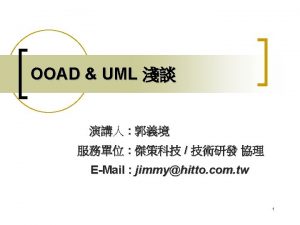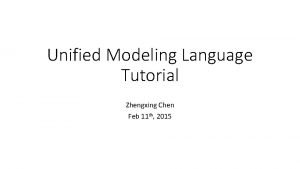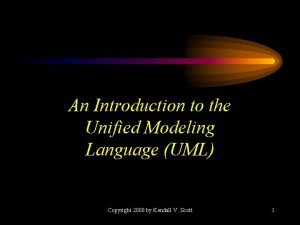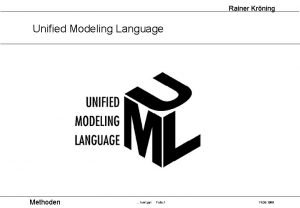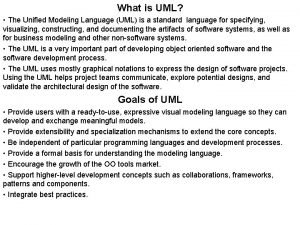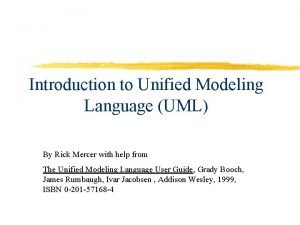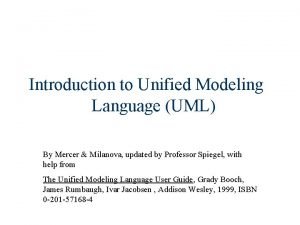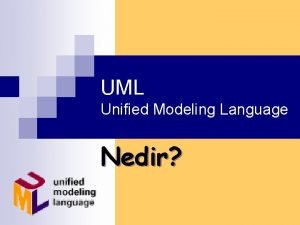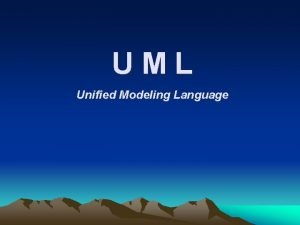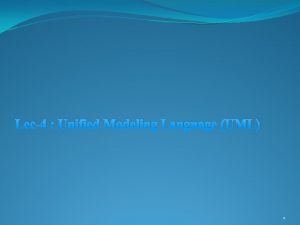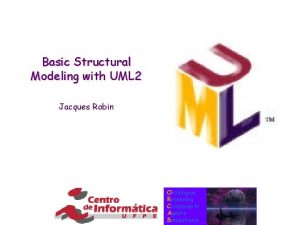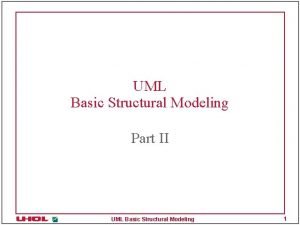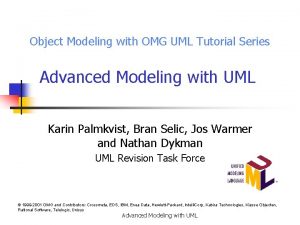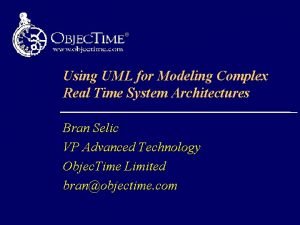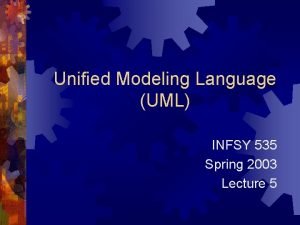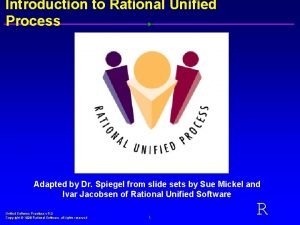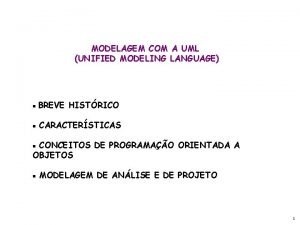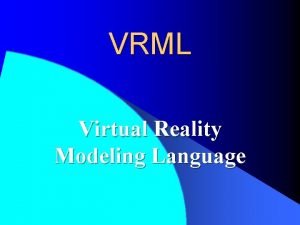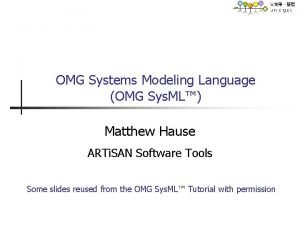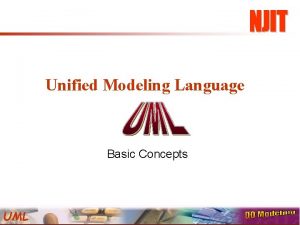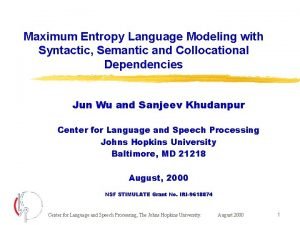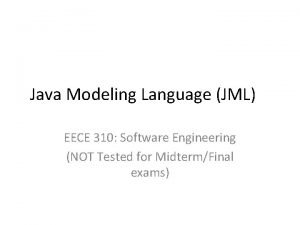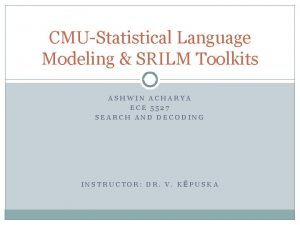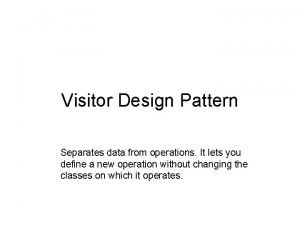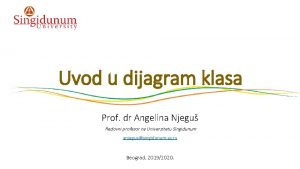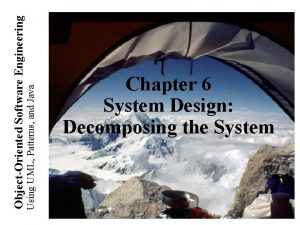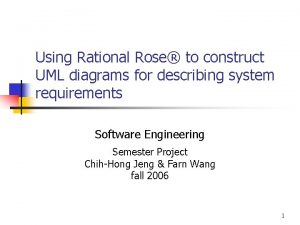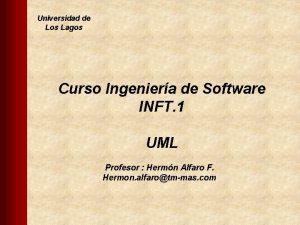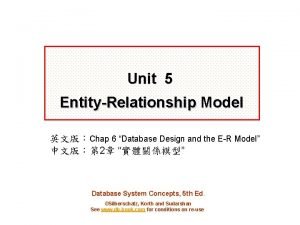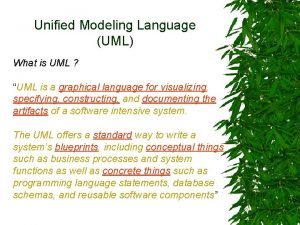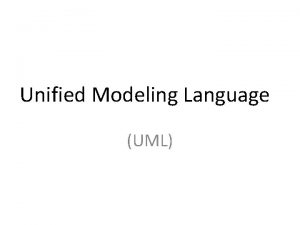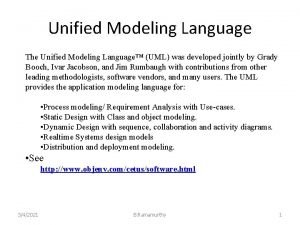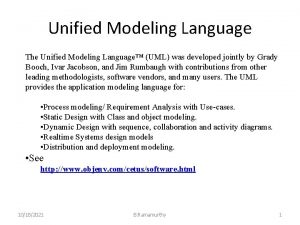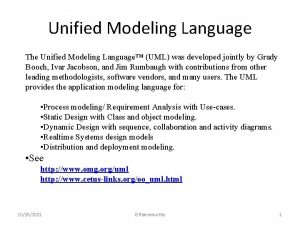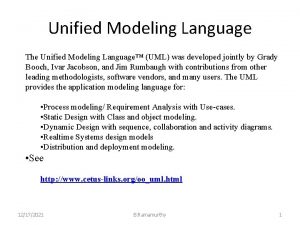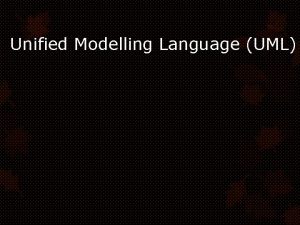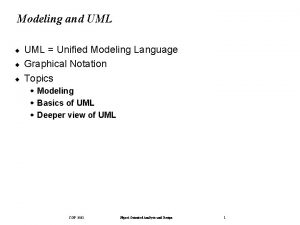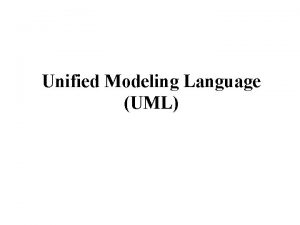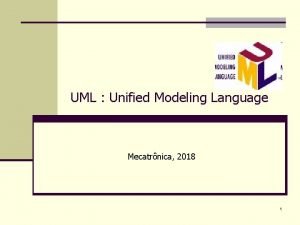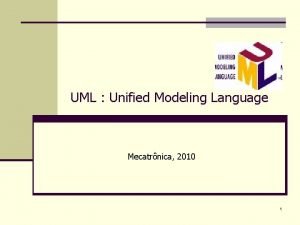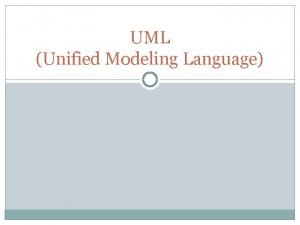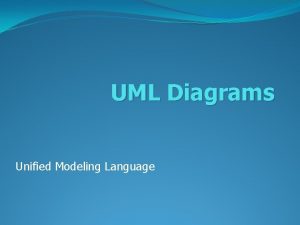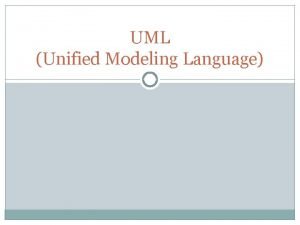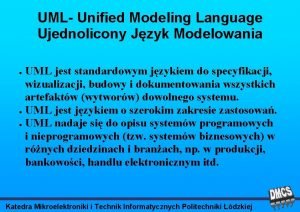Lec4 Unified Modeling Language UML 1 Unified Modeling








































- Slides: 40

Lec-4 : Unified Modeling Language (UML) 1

Unified Modeling Language (UML) � UML (Unified Modeling Language) is a graphical language that is suitable to express software or system requirements, architecture, and design. � UML used for both database and software modeling � UML modeling also supports multiple views of the same system. 2

UML diagrams � Can be categorized as the fallowing: � Structural diagrams: Show the building blocks of your system—features that don’t change with time. � Ex: Class diagram Behavioral diagrams: � Show your system responds to requests or otherwise evolves over time. � Ex: Use case diagram � Interaction diagrams: Is a type of behavioral diagram. To depict the exchange of messages within a collaboration (a group of cooperating objects). � Ex: Sequence diagram & Collaboration diagram 3

UML Diagrams � Another way of categorizing UML diagram: Static diagrams � to show the static features of the system. (no change) 2. Dynamic diagrams � to show your system evolves over time. 3. Functional diagrams: � to show the details of behaviors and algorithms. 1. 4

Object-oriented analysis (OOA) � Trying to figure out what the users and customers of a software effort want the System to do. � Builds a “real-world” model from requirements � client interviews, domain knowledge, real-world experience collected in use cases and other simple notations � OOA models address three aspects of the system (its objects) � class structure and relationships � sequencing of interactions and events � data transformations and computations 5

Static Modeling using the Unified Modeling Language (UML) UML Class Diagrams 6

Classes Class. Name attributes operations A class is a description of a set of objects that share the same attributes, operations, relationships, and semantics. Graphically, a class is rendered as a rectangle, usually including its name, attributes, and operations in separate, designated compartments.

Class Names Class. Name attributes operations Class naming: Use singular names because each class represents a generalized version of a singular object. The name of the class is always appears in the top-most compartment.

Class Attributes Person name : String address : Address birthdate : Date ssn : Id An attribute is a named property of a class that describes the object being modeled. In the class diagram, attributes appear in the second compartment just below the name-compartment. An object class is an abstraction over a set of objects with common: attributes (states) and the services (operations) (methods), provided by each object.

Class Attributes (Cont’d) Person Attributes are usually listed in the form: attribute. Name : Type name : String address : Address birthdate : Date / age : Date ssn : Id A derived attribute is one that can be computed from other attributes, but doesn’t actually exist. For example, a Person’s age can be computed from his birth date. A derived attribute is designated by a preceding ‘/’ as in: / age : Date

Class Operations Person name : String address : Address birthdate : Date ssn : Id eat sleep work play What the class knows Operations describe the class behavior and appear in the third compartment. What the class does

Depicting Classes When drawing a class, you needn’t show attributes and operation in every diagram. Class diagrams provide the representations used by the developers. Person name : String birthdate : Date ssn : Id Person name address birthdate Person eat play eat() sleep() work() play()

Objects 13

Generalization Relationships Person A generalization connects a subclass to its superclass. It denotes an inheritance of attributes and behavior from the superclass to the subclass and indicates a specialization in the subclass of the more general superclass. Student

(Cont’d) UML permits a class to inherit from multiple superclasses. Student Employee Teaching. Assistant

Association, aggregation and composition When considering the 3 relationships: association, aggregation and composition, • the most general relationship is association, • followed by aggregation • and, finally, composition. 16

Association Relationships If two classes in a model need to communicate with each other, there must be link between them. An association denotes that link. Student Instructor

(Cont’d) We can indicate the multiplicity of an association by adding multiplicity adornments to the line denoting the association. The example indicates that a Student has one or more Instructors: Student 1. . * Instructor

(Cont’d) The example indicates that every Instructor has one or more Students: Student 1. . * Instructor

(Cont’d) We can also indicate the behavior of an object in an association (i. e. , the role of an object) using rolenames. Student teaches 1. . * learns from 1. . * Instructor

(Cont’d) We can also name the association. Student membership 1. . * Team

(Cont’d) We can specify dual associations. member of 1. . * Student Team 1 president of 1. . *

(Cont’d) Associations can also be objects themselves, called link classes or an association classes. Registration model. Number serial. Number warrenty. Code Product Warranty

(Cont’d) A class can have a self association. next Linked. List. Node previous

Aggregations We can model objects that contain other objects by way of special associations called aggregations and compositions. An aggregation specifies a whole-part relationship between an aggregate (a whole) and a constituent part, where the part can exist independently from the aggregate. Aggregations are denoted by a hollow-diamond adornment on the association. Example: a bank (whole) has customers (as parts). Deleting a bank does not cascade deleting customers. Customers can move to another bank

Compositions A composition indicates a strong ownership and coincident lifetime of parts by the whole (i. e. , they live and die as a whole). Compositions are denoted by a filled-diamond adornment on the association. 1 Window 1 1 1. . * Scrollbar Titlebar Menu

(Cont’d) Example : A bank (whole) has many branches (parts). Branches can not exist independently of the whole (parts objects can NOT exist independently) � Deleting a bank (whole) cascades deleting branches (parts). But, if a branch (part) is deleted, the bank (whole) may remain. 27

Inheritance: is a “is a kind of” is a association. Child class ‘subclass’ can inherit attributes and operations from parent class‘superclass’. Example: An inheritance hierarchy in the animal kingdom 28

Class name Library item Attributes Generalisation Published item Recorded item Title Medium Title Publisher Book Author Edition Publication date ISBN Methods Operations Acquire () Catalogue () Dispose () Issue () Return () Is a Library class hierarchy Catalogue number Acquisition date Cost Type Status Number of copies Magazine Year Issue Film Director Date of release Distributor Computer program Version Platform 29

User class hierarchy Library user Name Address Phone Registration # Register () De-register () Reader Borrower Items on loan Max. loans Affiliation Staff Department phone Student Major subject Home address 30

Hierarchy Diagram (UML notation) PERSON Name, Address Phone, Sex Date of Birth Change. Address Enquire. DOB&Sex ISA CUSTOMER Balance O/Due 30, 60, 90 Credit Rating Date Paid Check. Cr. Rating Age. Balances EMPLOYEE This kind of arrowhead indicates that this relationship is one of subclassing SIN Marital Status No. of Dependants Date Hired Wage Rate Give. Raise Calc. Month. Pay 31

Multiple inheritance Rather than inheriting the attributes and services from a single parent class, a system which supports multiple inheritance allows object classes to inherit from several super -classes. 32

Example: Multiple inheritance The talking book Book Voice recording Author Edition Publication date ISBN Speaker Duration Recording date Talking book # Tapes 33

Summary of UML Class Diagram Notation 34

Summary of UML Class Diagram Notation 35

36

UML Example for Displaying Specialization / Generalization 37

UML Diagrams �Another way of categorizing UML static diagram: �Component Diagrams �Show the organizations and dependencies among software components. �Deployment Diagrams �Represent the distribution of components across the hardware topology 38

Component Diagrams 39

Deployment Diagrams 40
 Use case outline
Use case outline Unified modeling language tutorial
Unified modeling language tutorial Introduction to the unified modeling language
Introduction to the unified modeling language Ppt uml
Ppt uml Pengertian unified modeling language
Pengertian unified modeling language What-is-uml
What-is-uml Introduction to unified modeling language
Introduction to unified modeling language Introduction to unified modeling language
Introduction to unified modeling language Use case örnekleri
Use case örnekleri Fungsi dari uml
Fungsi dari uml Object diagram captures the behavior of a single use case.
Object diagram captures the behavior of a single use case. Mof uml
Mof uml Mda uml
Mda uml Uml 1..*
Uml 1..* Superstruture
Superstruture Basic structural modeling in uml
Basic structural modeling in uml Uml modeling tutorial
Uml modeling tutorial Erickson nursing theory
Erickson nursing theory Relational vs dimensional data modeling
Relational vs dimensional data modeling Language uml
Language uml Language uml
Language uml Language uml
Language uml Unified modelling language
Unified modelling language Virtual reality modeling language
Virtual reality modeling language Omg systems modeling language
Omg systems modeling language What does vrml stand for
What does vrml stand for Uml overview
Uml overview Uniform modeling language
Uniform modeling language Language modeling incorporates rules of
Language modeling incorporates rules of Java modeling language
Java modeling language Uml
Uml Srilm kndiscountn
Srilm kndiscountn Waeweb
Waeweb Visitor design pattern
Visitor design pattern Dijagram klasa
Dijagram klasa Uml blackboard
Uml blackboard Uml rational rose
Uml rational rose Uml
Uml Diagrama de clases ejemplos resueltos
Diagrama de clases ejemplos resueltos Composite multivalued attribute
Composite multivalued attribute Käyttötapauskaavio
Käyttötapauskaavio
